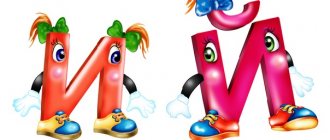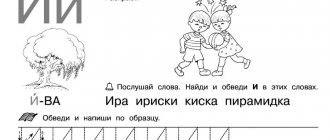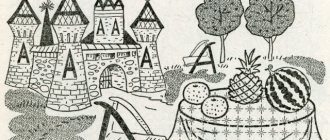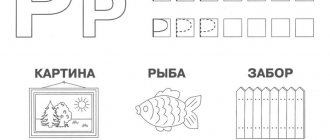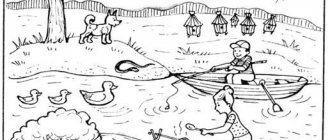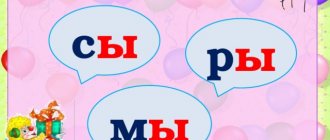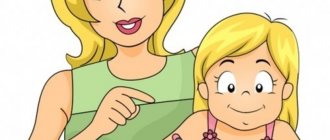Summary of a lesson on teaching literacy to older preschoolers “Sound [a] and letter A”
Lesson notes
“The sound [a] and the letter A”
for older children
Target:
introduce children to the letter A, which denotes the vowel sound [a];
characterize the sound, consolidate the correct pronunciation of the sound a
Tasks:
clarify the pronunciation of the sound [a];
teach children to distinguish the sound [a] from a number of other vowel sounds;
develop phonemic hearing and phonemic perception;
Progress of the lesson
Educator:
Guys, today the doll Anya came to visit us. She has prepared an interesting task for you. Look at the pictures and name them. (Children's answers).
Tell me what is the first sound we hear in all these words.
- That's right, the sound [a] is heard.
Children: They all start with the sound [A]
Educator: Let's all pronounce the sound [A] together (the teacher puts up a picture of the sound being pronounced) with the mouth open wide.
This sound is sung, and when we pronounce it in our mouth, we don’t feel any obstruction, which means it’s a vowel - repeat. We denote vowel sounds in red (red circle). The sound [A] is indicated by the letter A. (The letter A is set).
Development of articulatory motor skills.
- And to make it easier for us to speak, let's stretch our tongue and lips.
- lip exercises: smile – fence – proboscis
- exercises for the tongue: “delicious jam”, “watch”, “swing”.
- Now let's play. Let's pronounce the sound [a] silently, just with our lips - in a whisper - quietly - loudly. For this, the Anya doll prepared magic circles. If it shows a red circle, then you will pronounce the sound [a] loudly, blue - quietly, green - in a whisper, and if white - silently.
And the sound can be pronounced for a long time, aaaaaaaaaaaaaaa (the teacher pronounces the sound and moves the pointer along the path and pronounces the sound for a long time), or it can be pronounced briefly. A. (the teacher pronounces the sound and moves the pointer along the path and pronounces the sound briefly).
Game “Find out by sound”
.
- Now get your palms ready. You need to clap your hands when you hear the sound [A]. Be careful, let's start the game:
- A, U, I, M, O, A, S, E
- SA, KU, PY, SO, DI; AS, OS, UM, US, AP
- garden, tree, crayfish, juice, tap, braid, meat, candy.
Physical education minute
Hands up and into a fist,
Hands down and on your side
We'll sit down and say wow
We'll stand up and say, ah-ah-ah
It's time for us to get down to business. (repeat 2 times).
Educator:
Guys, I already said that the sound [A] is indicated by the letter A. (show the letter A)
Save it!!! We hear and pronounce the sound, and we see and write the letter.
Look how I write it. (The teacher writes a letter on the board) and says: shelf, stick and line - the result is the letter A.
Work in notebooks.
We write the printed letter A, and draw a circle next to it with a red felt-tip pen.
Summary of educational activities for teaching literacy in the senior group.
Author: Yatsenko Vera Borisovna
teacher of the preschool educational institution "Kindergarten No. 157", Magnitogorsk
Summary of educational activities for teaching literacy in the senior group.
Summary of educational activities for teaching literacy (senior group)
Topic: Sounds “G-K”, “K-K”. Letters "G", "K". Reading syllables, composing and writing sentences.
Target:
Contribute to the development of sound-letter analysis. Introduce the sounds “G-K” as voiced and voiceless consonants. Introduce the sounds “Г-Гь”, “К-Кь”. Strengthen the ability to use symbols of consonant and vowel sounds: blue square - hard sounds, green square - soft sounds, red square - vowel sounds. Develop the ability to listen carefully to the text of a poem, select words that are not only close in sound, but also suitable in meaning. Introduce the letters “G”, “K” as written signs of consonant sounds. Develop the skill of writing the printed letters “G”, “K”, first using dots, then independently. Introduce how to read syllables with “G” + 10 vowels, with “K” + 10 vowels. Continue to help children master composing three-word sentences based on a story picture. Develop the ability to write a sentence using symbols. Develop the ability to understand a learning task and complete it independently. Develop the skills of self-control and self-esteem.
Material and equipment:
Musical instruments: drum and bell.
Progress:
- Comparison of drum and bell sounds
. (voiced - voiceless).
With fingers, palms, elbows, mallets, people hit and try to hit the top of his head. I can only tell you one thing - this is a well-known musical instrument
(drum)
He sits under his cap, don’t disturb him - he’s silent. All you have to do is take him in your hands and rock him a little, and you can hear the chime: “Dili-don, dili-don. "(Bell)
I invite the children to listen to the sounds of a bell and a drum.
The drum has a dull sound, but the bell has a ringing sound.
- Game "Give me a word."
Name the first sound in the given words.
I respect water very much in any bad weather.
I keep away from dirt the clean gray...(goose).
I didn’t tremble before the wolf, I ran away from the bear,
But the fox still got a bite... (gingerbread man).
Conduct a comparative analysis of the sounds “G” and “K”.
- Game "Word, scheme".
Name the picture whose title contains the first sound “K”. (Cat)
Name the picture whose title contains the first sound “Кь”. (Whale)
Are the first sounds in these words pronounced the same way? (No, in the word CAT - K, KIT - Kb)
Color the square under the picture with the appropriate color.
Name the picture whose title contains the first sound “G”. (Peas)
Name the picture whose title contains the first sound “Гь”. (Weight)
Are the first sounds in these words pronounced the same way? (no, in the word peas there is a G sound, and in
word kettlebell Gb).
What color did you paint the square under the picture of peas? (Blue,
because the G sound sounds hard).
What color did you paint the square under the picture showing the weight? (Green,
because the sound Гь sounds soft).
- Fizminutka:
—
Are you tired?
- What are you, what are you no, no, no.
Game “Name it kindly” with a ball
(nose - spout, mouth, eye, forehead, elbow, finger, belly, nail, hair). What sound is heard at the end of a kind word? (TO)
- Game exercise “Syllabic houses”.
The letters G and K are written in the left corner, and their comic image is in the right corner.
The letter G is completely different: it is slender, straight,
Keep your nose ahead so you know where to go.
Write the letter G in syllabic houses, first using dots, then independently. Read the syllables in the syllable houses.
I can tell you with confidence about the letter K - a butterfly sat on the wall.
Write the letter K in syllabic houses, first using dots, then independently. Read the syllables in the syllable houses.
In what cases are consonants pronounced as hard, and in what cases are they pronounced as soft?
(If the vowels A, O, U, Y, E are written after them, then they are pronounced as hard consonants; if the vowels are I, Yu, E, Yo, I, then they are pronounced as soft consonants). Come up with a pure saying with the syllable GA, KU.
- Compose and write a sentence in symbols.
Make up a sentence based on the picture using three words.
Write it down in the form of a diagram (Three rectangles -
Name the first word in the sentence. Second. Third).
Guys, what sounds did we meet today?
G – voiced, K – voiceless.
- Game “Come up with a word starting with “G” and “K”.
Let's have a competition.
Whoever comes up with more ideas will get more chips.
Guys, evaluate your work in class.
Target.Teach children to isolate the sound [a] in a stressed position at the beginning of a word; start introducing vowel sounds; practice expressive pronunciation of words, the ability to determine the sequence of sounds in onomatopoeic words; focus on the plane of the sheet (direction from top to bottom); draw straight lines from top to bottom; familiarize yourself with the image of the letter Aa.
Equipment.
A set of pictures and toys, panels of letters; individual sheets of white paper with clouds drawn at the top, pencils for each child; sound houses.
Progress of the lesson
I. 1. The teacher tells the story, highlighting (drawing out) the sound [a] in the words with his voice.
- I'll tell you about one dog. She was looking for a friend. The dog wandered down the street and looked into the eyes of passers-by. But no one paid attention to her. A girl ran past with a bouquet of asters. One flower fell. The girl was in a hurry and did not notice the loss. The dog took the flower in its teeth, caught up with the girl and placed the aster in front of her. The girl smiled and said: “Come with me!” The dog was happy and ran after the girl. This is how a homeless dog found a friend.
The girl's name was A-nya. She named the dog A-lyy, because the a-stra that the dog picked up was A-lyy.
All these words, A-nya, A-ly, a-stra, a-laya, begin with the same sound. When I spoke the words, I emphasized this sound.
Name this sound ([a]). Repeat words with the sound [a].
Articulation of sound. When we pronounce the sound [a], the mouth is wide open, the tongue lies behind the lower teeth. The sound is pronounced with the voice. The air stream does not encounter any obstacles on its path.
We will call sounds that are pronounced with the voice and do not encounter obstacles in the mouth as vowels. We will mark the windows in the sound houses where vowel sounds live in red.
Characteristics of sound. The sound [a] is a vowel.
2. - I will name the words. And you repeat them, emphasizing the sound [a] with your voice; the sound is at the beginning of the word: August, address, iceberg, stork, arch. (If necessary, enter an explanation of the meaning of words by the children, and clarification by the teacher)
II. 1. — Our Scarlet barked in a special way. His bark always began with the sound [a]. Guess how he barked: yap, aw, woof? (av).
2. - What is the first sound heard here? ([A]). Sequencing sounds using a sound house. The house has two windows; The first window is red.
3. - Dogs bark in different ways: some loudly, others quietly, some plaintively, others cheerfully. Show how Scarlet barked in the following situations: when he was happy with Anya (loudly), when he was afraid to wake up the owners (quietly), when he was lazy (slowly), when he was chasing the neighbor’s dogs (loudly and often).
III. 1. Getting to know the image of a letter.
- What sound did we meet today? ([A]). I will show you a letter sign that represents the sound [a]. (Show the letter) All letters will live in our group, in their own house. (Showing panels of letters) This house has six floors, each floor has 5-6 apartments. The letter Aa lives at the address: sixth floor (topmost row), apartment No. 1. (Children, with the help of the teacher, find the desired square on the panel and attach the letter to it)
2. Analysis of the letter image.
The teacher examines the letter with the children and asks:
— How many elements are in a letter? (Three) What elements? (Sticks) Are all sticks the same? (No. Two sticks are long, one is short.)
The teacher invites the children to verify the correctness of their observations. Working with scissors. Children cut up the letters given to them. Place the resulting elements in a row. They repeat which elements and in what quantities are needed to obtain the image of the letter A.
3. Letter synthesis.
The teacher offers to form the letter A again from the received elements.
4. The teacher suggests identifying the missing element of the letter. (The letter A has lost one long stick)
"A" ran along the path
And she broke her leg.
IV. Exercise “It’s Raining” to develop orientation on a sheet of paper and reinforce the direction from top to bottom.
“It’s time for us to say goodbye to the girl Anya and her new friend, the dog Scarlet.” They helped us a lot. We introduced them to the sound [a] and the letter A. Anya and Aly are in a hurry to go home, as it is raining outside. (Children take sheets of white paper and pencils)
— Drops from the clouds flew to the ground. Where are the clouds? (Above) How does it rain? (Down) Rain comes from top to bottom Let's draw autumn rain.
Children draw rain (straight vertical lines). The teacher makes sure that their movements are directed from top to bottom. Children can accompany actions by quietly pronouncing words from top to bottom.
